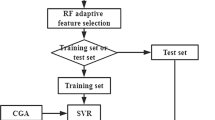Abstract
The accurate prediction of vehicle speed plays an important role in vehicle’s real-time energy management and online optimization control. However, the current forecast methods are mostly based on traffic conditions to predict the speed, while ignoring the impact of the driver-vehicle-road system on the actual speed profile. In this paper, the correlation of velocity and its effect factors under various driving conditions were firstly analyzed based on driver-vehicle-road-traffic data records for a more accurate prediction model. With the modeling time and prediction time considered separately, the effectiveness and accuracy of several typical artificial-intelligence speed prediction algorithms were analyzed. The results show that the combination of niche immunegenetic algorithm-support vector machine (NIGA-SVM) prediction algorithm on the city roads with genetic algorithm-support vector machine (GA-SVM) prediction algorithm on the suburb roads and on the freeway can sharply improve the accuracy and timeliness of vehicle speed forecasting. Afterwards, the optimized GA-SVM vehicle speed prediction model was established in accordance with the optimized GA-SVM prediction algorithm at different times. And the test results verified its validity and rationality of the prediction algorithm.
Similar content being viewed by others
References
Zhang S, Xiong R. Adaptive energy management of a plug-in hybrid electric vehicle based on driving pattern recognition and dynamic programming. Appl Energy, 2015, 155: 68–78
Chindamo D, Economou J T, Gadola M, et al. A neurofuzzy-controlled power management strategy for a series hybrid electric vehicle. Proc Inst Mech Eng Part D-J Auto Eng, 2014, 228: 1034–1050
Baker D, Asher Z, Bradley T. Investigation of vehicle speed prediction from neural network fit of real world driving data for improved engine on/off control of the EcoCAR3 hybrid Camaro. SAE Technical Papers, 2017
Mozaffari L, Mozaffari A, Azad N L. Vehicle speed prediction via a sliding-window time series analysis and an evolutionary least learning machine: A case study on San Francisco urban roads. Eng Sci Tech Int J, 2015, 18: 150–162
Rumschlag G, Palumbo T, Martin A, et al. The effects of texting on driving performance in a driving simulator: The influence of driver age. Accident Anal Prev, 2015, 74: 145–149
Birrell S A, Young M S. The impact of smart driving aids on driving performance and driver distraction. Trans Res Part F-Traffic Psychol Behav, 2011, 14: 484–493
Garber N J, Gadiraju R. Factors affecting speed variance and its influence on accidents. Trans Res Record, 1989, 1213: 64–71
Hu W. Raising the speed limit from 75 to 80 mph on Utah rural interstates: Effects on vehicle speeds and speed variance. J Saf Res, 2017, 61: 83–92
Ashley W S, Strader S, Dziubla D C, et al. Driving blind: Weatherrelated vision hazards and fatal motor vehicle crashes. Bull Amer Meteorol Soc, 2015, 96: 755–778
Beratis I N, Pavlou D, Papadimitriou E, et al. Mild cognitive impairment and driving: Does in-vehicle distraction affect driving performance? Accident Anal Prevention, 2017, 103: 148–155
Zuin D, Ortiz H, Boromei D, et al. Motor vehicle crashes and abnormal driving behaviours in patients with dementia in Mendoza, Argentina. Eur J Neurol, 2002, 9: 29–34
Alvarez R, López A, De la Torre N. Evaluating the effect of a driver’s behaviour on the range of a battery electric vehicle. Proc Inst Mech Eng Part D-J Auto Eng, 2015, 229: 1379–1391
Lawoyin S, Fei D Y, Bai O. Accelerometer-based steering-wheel movement monitoring for drowsy-driving detection. Proc Inst Mech Eng Part D-J Auto Eng, 2015, 229: 163–173
Jägerbrand A K, Sjöbergh J. Effects of weather conditions, light conditions, and road lighting on vehicle speed. Springerplus, 2016, 5: 505
Davies G M, Patel D. The influence of car and driver stereotypes on attributions of vehicle speed, position on the road and culpability in a road accident scenario. Legal Criminol Psychol, 2005, 10: 45–62
Jiang B, Fei Y. Vehicle speed prediction by two-level data driven models in vehicular networks. Trans Intel Trans Sys, 2017, 99: 1–9
Lai W K, Kuo T H, Chen C H. Vehicle speed estimation and forecasting methods based on cellular floating vehicle data. Appl Sci, 2016, 6: 47
Vapnik V N, Chervonenkis A Y A. On the uniform convergence of relative frequencies of events to their probabilities. Theor Probab Appl, 1971, 1: 264–280
Vapnik V N. The Nature of Statistical Learning Theory. Berlin: Springer-Verlag, 1995. 988–999
Cortes C, Vapnik V. Support-Vector Networks. Dordrecht: Kluwer Academic Publishers, 1995. 273–297
Holland J H. Adaptation in natural and artificial systems. Quart Rev Biol, 1975, 6: 126–137
Horn J. The nature of niching: Genetic algorithms and the evolution of optimal, cooperative populations. Ph.D. thesis, Urbana, University of Illinois, Illinois, Genetic Algorithm Lab, 1997.
Chun J S, Jung H K, Hahn S Y. A Study on comparison of optimization performances between immune algorithm and other heuristic algorithms. In: IEEE Transactions on Magnetics, 1998, 34: 2972–2975
Author information
Authors and Affiliations
Corresponding author
Rights and permissions
About this article
Cite this article
Li, Y., Chen, M., Lu, X. et al. Research on optimized GA-SVM vehicle speed prediction model based on driver-vehicle-road-traffic system. Sci. China Technol. Sci. 61, 782–790 (2018). https://doi.org/10.1007/s11431-017-9213-0
Received:
Accepted:
Published:
Issue Date:
DOI: https://doi.org/10.1007/s11431-017-9213-0




